This article was co-authored by Andrea Rudominer, MD, MPH. Dr. Andrea Rudominer is a board certified Pediatrician and Integrative Medicine Doctor based in the San Francisco Bay Area. Dr. Rudominer has over 15 years of medical care experience and specializes in preventive health care, obesity, adolescent care, ADHD, and culturally competent care. Dr. Rudominer received her MD from the University of California, Davis, and completed a residency at the Lucile Packard Children's Hospital at Stanford University. Dr. Rudominer also has an MPH in Maternal Child Health from the University of California, Berkeley. She is a Member of the American Board of Pediatrics, a Fellow of the American Academy of Pediatrics, a Member and Delegate of the California Medical Association, and a Member of the Santa Clara County Medical Association.
There are 9 references cited in this article, which can be found at the bottom of the page.
wikiHow marks an article as reader-approved once it receives enough positive feedback. This article has 23 testimonials from our readers, earning it our reader-approved status.
This article has been viewed 513,283 times.
Heat rash (also known by its scientific name, Miliaria) is a condition caused when the skin's sweat glands are blocked, trapping sweat beneath the skin. It is triggered by heat, meaning that working hard in the heat or sunbathing can cause it.[1] The irritation and dotted red "pinprick" rash that results can be anything from a minor nuisance to a serious problem depending on how far they are allowed to progress. Luckily, the condition is easy to get rid of if you treat it early. Use these easy tricks to clear up a minor case of heat rash!
Steps
Easy Home Remedies
-
1Stay out of the heat. As its name suggests, one of the main causes of heat rash is exposure to hot weather that encourages sweating. The less you sweat, the less sweat will build up behind your blocked pores and the less irritated your rash will be. Thus, the more time you can spend out of hot weather, the better.[2]
- If you have access to it, spending time in an air-conditioned area is a very good idea. Not only does air conditioning make the air cooler — it also makes it much less humid. This is a big help when it comes to fighting heat rash, as high humidity keeps sweat from evaporating, worsening heat rash.
-
2Wear loose, "breathable" clothing. If you're suffering from heat rash, it's wise to wear clothes that exposes your skin to fresh air. This gives the sweat and moisture on the skin a chance to evaporate and prevents moisture from building up around the rash like it would with tight clothing.[3]
- It's not just about the clothes you wear — it's also about what they're made of. Fabrics like cotton and more breathable, jersey-like exercise weaves tend to be best, while sheer artificial fabrics like nylon and polyester are least breathable.
- If you're in hot weather, you may not want to wear clothes that outright expose your skin (like shorts, tank tops, etc.) These garments run the risk of sunburn, which will just make your skin more irritated and vulnerable to damage. Apply sunscreen generously or stick to loose but skin-covering clothes.
- Manual workers such as lawn mowers may try wetting their clothes before work. They should wear long sleeves and continue to add moisture to the clothes to prevent heat rash.
Advertisement -
3Avoid hard physical activity. Exercise raises your body temperature and makes you sweat — exactly what you don't want when you have a heat rash. Though physical activity is great for long-term health, in the short term, it can keep a heat rash from healing and even make it worse. Take the opportunity to avoid intense physical activities while you're waiting for your rash to get better, especially if you would be doing them in hot, humid environments. This includes:
- Sports
- Hiking
- Running
- Weightlifting/calisthenics
- ...and so on.
-
4Use soothing powder to dry the skin. Sometimes, especially in hot and humid climates, it can be difficult to keep heat rash-affected skin completely dry, even if you avoid exercise. In these cases, try applying a small amount of talcum powder, baby powder, or corn starch (in a pinch) to the affected area. These powders absorb moisture, keeping the skin dry.[4]
- Try to shower first, dry, and then apply the powder. Corn starch can be more effective if you are able spend some time without a shirt on at home.
- Don't use scented or perfumed powders, which can irritate rash-affected skin. You also will not want to apply any sort of powder to open wounds, as this can lead to infection.
-
5Bathe frequently and let your skin air dry. Keeping the skin clean is important when you have virtually any kind of rash. Dirt, grime, and bacteria can all make a heat rash worse by starting an infection, but regular bathing (at least once per day while you have a rash) can help keep your skin free of these contaminants. When you do bathe, don’t rub yourself dry with the towel. Instead, let the water gradually air dry or pat it dry with your towel.[5] Towels can irritate the skin further and transfer infection-causing bacteria on to it.
-
6Give the skin a chance to get fresh air every day. When you have a heat rash, remember — you don't have to wear the same clothes all day. If your work or other responsibilities keep you from wearing the sorts of breathable clothes that are best for heat rash, take them off when you get a chance to rest. This isn't an ideal situation, but giving the skin a chance to breathe some of the time is better than never giving it a chance to breathe at all.
- For example, let's say you're in a hot, humid jungle and you have heat rash on your foot. However, your work requires you to wear thick rubber boots. In this case, you might try switching to a loose pair of sandals at the end of each day after your cool-off shower. Exposing your heat rash to fresh air as often as possible will only help your situation.
Topical Treatments for More Serious Cases
-
1Avoid standard creams and lotions. Sometimes, a heat rash just won't go away on its own. In these cases, there are some creams and lotions that can help accelerate the healing process. However, these are the exception, not the rule. Most creams and lotions will not help a case of heat rash, even if they're advertised as "soothing" or "moisturizing." In fact, many can even make heat rash worse, especially if they contain one of the following ingredients:
- Hydrocortisone. Many people assume that hydrocortisone will soothe the rash. In fact, it does not help and may make it worse.
- Petroleum or mineral oil. These greasy ingredients can clog the pores, which is the main cause for heat rash in the first place.[6]
- Perfumes or scents. These can often irritate raw skin, making heat rash worse.
-
2Apply a gentle calamine lotion. Calamine is an ingredient that soothes and protects the skin, reducing irritation. In addition, it's known reduce the itching that can sometimes come with a case of heat rash.[7] This and related lotions are sometimes marketed as "prickly rash lotions."
- While calamine is the best option, it is wet and sticks to clothes. Try putting the calamine on and giving it time to dry. You might apply it and then sit under a fan, for example. At night, apply calamine and then get into clean sheets. Remember that calamine can stain – therefore, don't use it with your best bedding.
- Calamine is generally safe, but it can negatively interact with some common medications and medical conditions. Talk to your doctor before using calamine if you are pregnant, have any known medical allergies, or are taking prescription medication.[8]
- Calamine lotion is an over-the-counter (OTC) drug.
-
3Apply anhydrous lanolin. This is a similarly soothing ingredient that is sometimes prescribed for heat rash. Anhydrous lanolin reduces irritation and helps reduce blockage of the sweat glands, fighting the root cause of the heat rash.[9]
- Some people whose skin is sensitive to wool may experience irritation after using this ingredient.[10] Avoid it if this is true for you.
- Anhydrous lanolin is an OTC drug.
-
4Apply topical steroids. Steroids are a class of drugs that work by reducing inflammation, irritation, and swelling in the area they are applied to.[11] A thin layer of steroid ointment applied over the heat rash can seriously reduce the redness and "rawness" of the rash, speeding healing. Use steroid creams sparingly.
- Milder steroid creams are usually OTC drugs. These are not the same as dangerous anabolic steroids used to encourage muscle growth.
- Topical steroids may be sticky and moist, however, so it’s best to use them at night, if at all. It is difficult to apply a topical lotion and then put your clothes on successfully.
-
5Know when a case of heat rash requires a doctor's visit. If allowed to worsen, mild heat rashes can gradually develop to the point that they become more than a mild problem. Be on the lookout for signs of danger and infection. If you notice any of the symptoms below, contact a doctor as soon as possible to start a more aggressive treatment plan. This is especially urgent if the person with the rash is a baby, an elderly person, or someone with a weakened immune system.[12]
- Increased pain
- Increased swelling and irritation that does not go away
- Fever
- Pus or discharge oozing from the rash
- Swollen lymph nodes in the throat, groin, or armpits
Expert Q&A
Did you know you can get expert answers for this article?
Unlock expert answers by supporting wikiHow
-
QuestionWhy does my baby keep getting heat rash?
 Andrea Rudominer, MD, MPHDr. Andrea Rudominer is a board certified Pediatrician and Integrative Medicine Doctor based in the San Francisco Bay Area. Dr. Rudominer has over 15 years of medical care experience and specializes in preventive health care, obesity, adolescent care, ADHD, and culturally competent care. Dr. Rudominer received her MD from the University of California, Davis, and completed a residency at the Lucile Packard Children's Hospital at Stanford University. Dr. Rudominer also has an MPH in Maternal Child Health from the University of California, Berkeley. She is a Member of the American Board of Pediatrics, a Fellow of the American Academy of Pediatrics, a Member and Delegate of the California Medical Association, and a Member of the Santa Clara County Medical Association.
Andrea Rudominer, MD, MPHDr. Andrea Rudominer is a board certified Pediatrician and Integrative Medicine Doctor based in the San Francisco Bay Area. Dr. Rudominer has over 15 years of medical care experience and specializes in preventive health care, obesity, adolescent care, ADHD, and culturally competent care. Dr. Rudominer received her MD from the University of California, Davis, and completed a residency at the Lucile Packard Children's Hospital at Stanford University. Dr. Rudominer also has an MPH in Maternal Child Health from the University of California, Berkeley. She is a Member of the American Board of Pediatrics, a Fellow of the American Academy of Pediatrics, a Member and Delegate of the California Medical Association, and a Member of the Santa Clara County Medical Association.
Board Certified Pediatrician & Integrative Medicine Doctor It's possible that you're overdressing them for bed. Remember the rule of thumb: only one extra layer than you feel comfortable in. Over-bundling your baby can lead to overheating, which can cause heat rash. If you can, purchase breathable, organic cotton clothing. A cotton sleep sack that is a wearable blanket is a great option in the winter or cooler nights. Babies can also wear beanies to keep their heads warm. Avoid blankets or any loose clothing that can cause a risk for suffocation.
It's possible that you're overdressing them for bed. Remember the rule of thumb: only one extra layer than you feel comfortable in. Over-bundling your baby can lead to overheating, which can cause heat rash. If you can, purchase breathable, organic cotton clothing. A cotton sleep sack that is a wearable blanket is a great option in the winter or cooler nights. Babies can also wear beanies to keep their heads warm. Avoid blankets or any loose clothing that can cause a risk for suffocation. -
QuestionShould I apply calamine or lanoline when I get hot or before?
 Jurdy Dugdale, RNJurdy Dugdale is a Registered Nurse in Florida. She received her Nursing License from the Florida Board of Nursing in 1989.
Jurdy Dugdale, RNJurdy Dugdale is a Registered Nurse in Florida. She received her Nursing License from the Florida Board of Nursing in 1989.
Medical Review Board
-
QuestionWill cocoa butter help heat bumps?
 Jurdy Dugdale, RNJurdy Dugdale is a Registered Nurse in Florida. She received her Nursing License from the Florida Board of Nursing in 1989.
Jurdy Dugdale, RNJurdy Dugdale is a Registered Nurse in Florida. She received her Nursing License from the Florida Board of Nursing in 1989.
Medical Review Board
References
- ↑ http://www.mayoclinic.org/diseases-conditions/heat-rash/basics/causes/con-20033908
- ↑ http://www.medicinenet.com/heat_rash/page5.htm
- ↑ Andrea Rudominer, MD, MPH. Board Certified Pediatrician & Integrative Medicine Doctor. Expert Interview. 13 April 2020.
- ↑ http://www.webmd.com/parenting/baby/ss/slideshow-baby-skin-care
- ↑ http://www.webmd.com/skin-problems-and-treatments/tc/heat-rash-topic-overview
- ↑ http://www.webmd.com/skin-problems-and-treatments/tc/heat-rash-topic-overview
- ↑ https://www.drugs.com/cons/calamine-lotion-topical.html
- ↑ https://www.drugs.com/cons/calamine-lotion-topical.html
- ↑ http://www.osteopathic.org/osteopathic-health/about-your-health/health-conditions-library/general-health/Pages/heat-rash.aspx
- ↑ http://www.osteopathic.org/osteopathic-health/about-your-health/health-conditions-library/general-health/Pages/heat-rash.aspx
- ↑ https://patient.info/skin-conditions/sun-and-sunburn/prickly-heat-and-heat-rash-miliaria
- ↑ http://www.mayoclinic.org/diseases-conditions/heat-rash/basics/symptoms/con-20033908
- ↑ Andrea Rudominer, MD, MPH. Board Certified Pediatrician & Integrative Medicine Doctor. Expert Interview. 13 April 2020.
About This Article
To get rid of mild heat rash, wear loose, breathable clothing in materials like cotton and jersey, which will allow sweat and moisture on your skin to evaporate. Avoid hard physical activity or spending time outdoors in the heat, which will only make your heat rash worse, and let your skin air dry after a shower. If you’re in a hot and humid climate, apply a small amount of talcum or baby powder to the affected area to absorb moisture and keep the skin dry. For tips on treating serious heat rash, keep reading.
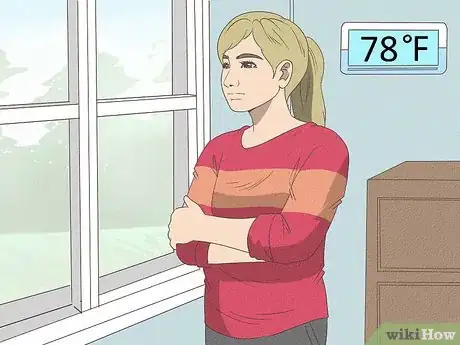


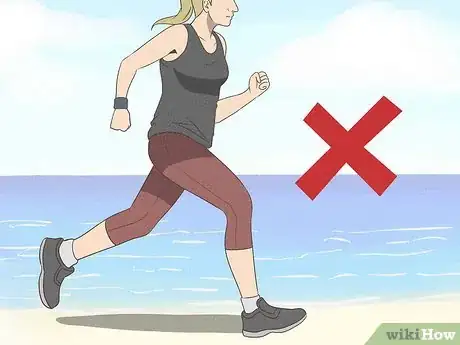
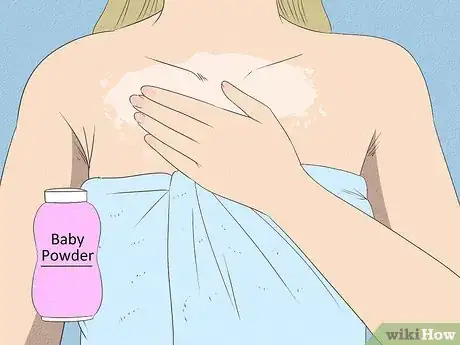
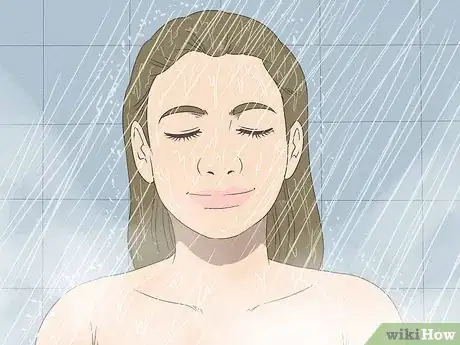
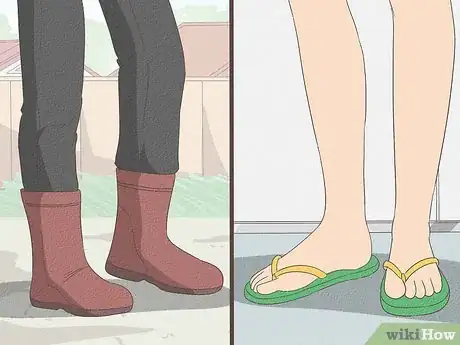

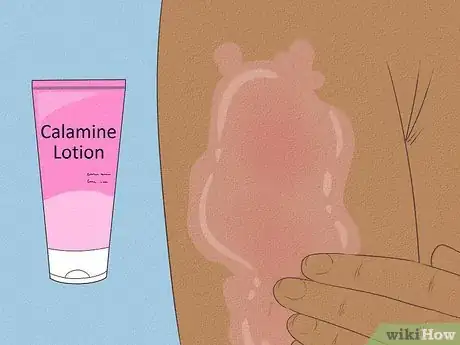
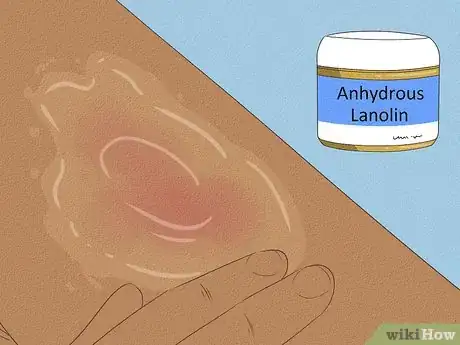
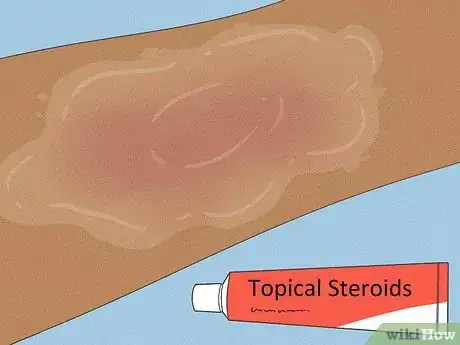
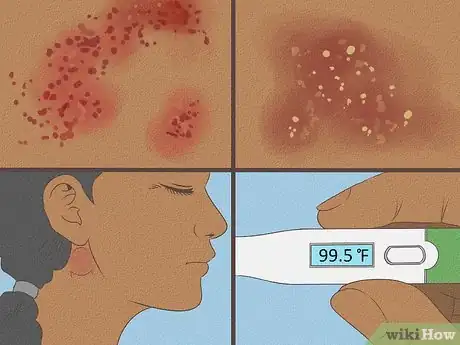


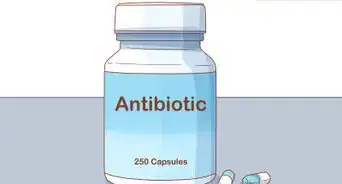

























































Medical Disclaimer
The content of this article is not intended to be a substitute for professional medical advice, examination, diagnosis, or treatment. You should always contact your doctor or other qualified healthcare professional before starting, changing, or stopping any kind of health treatment.
Read More...